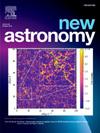Orbital period variation of W UMa binary star V2802 Orionis
IF 1.9
4区 物理与天体物理
Q2 ASTRONOMY & ASTROPHYSICS
引用次数: 0
Abstract
This study investigates the orbital period variation and physical parameters of the eclipsing binary system V2802 Orionis. Observations were conducted at the Regional Observatory for the Public, Nakhon Ratchasima (ROP-NMA), under the National Astronomical Research Institute of Thailand (NARIT), using Johnson-Cousins B, V, RC, and IC filters. Light curves obtained between 2021 and 2023 were analyzed with the Wilson–Devinney (W-D) code, revealing a mass ratio of q = 2.902(±0.006), an inclination of i = 88.6(±0.4) degree, and a secondary star temperature T2 = 5030(±3) K. Our results indicate that V2802 Orionis is a W-type W UMa binary star with a shallow degree of contact (16.6 %) and variability due to a spot on the primary component. The orbital period shows a secular decrease at a rate of 1.12(±0.09)×10−7 day year−1, attributed to mass transfer from the more massive to the less massive component. Additionally, a period variation with a cycle 5.1(±0.1) years suggests the presence of a third body, with a mass of 0.14(±0.01) M☉ and a separation of 3.2(±0.1) AU from the binary system. The masses, radii, and luminosities of the primary and secondary stars are estimated as M1 = 0.65(±0.001) M☉, M2 = 0.77 M☉, R1 = 0.56(±0.01) R☉, R2 = 0.91(±0.01) R☉, L1 = 0.21(±0.01) L☉, and L2 = 0.48(±0.01) L☉. Evolutionary analysis on the Hertzsprung-Russell diagram shows that the primary star (less massive) has evolved away from the main-sequence, while the secondary (more massive) remains on the main sequence star.
wuma双星V2802的轨道周期变化
本文研究了猎户座V2802月食双星系统的轨道周期变化和物理参数。观测是在泰国国家天文研究所(NARIT)的区域公众天文台(ROP-NMA)进行的,使用Johnson-Cousins B, V, RC和IC滤波器。利用Wilson-Devinney (W- d)编码分析了2021 - 2023年间的光曲线,得到了质量比q = 2.902(±0.006),倾角i = 88.6(±0.4)度,副星温度T2 = 5030(±3)k的结果。我们的结果表明,猎户座V2802是一颗W型wuma双星,接触度较浅(16.6%),并且由于主成分上有一个斑点而发生变化。轨道周期以1.12(±0.09)×10−7天(年−1)的速率减少,这是由于质量从质量较大的部分转移到质量较小的部分。此外,5.1(±0.1)年的周期变化表明存在第三个天体,质量为0.14(±0.01)M☉,与双星系统的距离为3.2(±0.1)AU。主星和副星的质量、半径和光度估计为M1 = 0.65(±0.001)M☉,M2 = 0.77 M☉,R1 = 0.56(±0.01)R☉,R2 = 0.91(±0.01)R☉,L1 = 0.21(±0.01)L☉,L2 = 0.48(±0.01)L☉。赫茨普龙-罗素图的演化分析表明,主星(质量较小)已经从主序星演化而来,而次星(质量较大)仍然在主序星上。
本文章由计算机程序翻译,如有差异,请以英文原文为准。
求助全文
约1分钟内获得全文
求助全文
来源期刊

New Astronomy
地学天文-天文与天体物理
CiteScore
4.00
自引率
10.00%
发文量
109
审稿时长
13.6 weeks
期刊介绍:
New Astronomy publishes articles in all fields of astronomy and astrophysics, with a particular focus on computational astronomy: mathematical and astronomy techniques and methodology, simulations, modelling and numerical results and computational techniques in instrumentation.
New Astronomy includes full length research articles and review articles. The journal covers solar, stellar, galactic and extragalactic astronomy and astrophysics. It reports on original research in all wavelength bands, ranging from radio to gamma-ray.
 求助内容:
求助内容: 应助结果提醒方式:
应助结果提醒方式:


